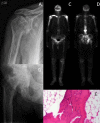Premalignant Conditions of Bone
- PMID: 36227850
- PMCID: PMC9575816
- DOI: 10.5435/JAAOSGlobal-D-22-00097
Premalignant Conditions of Bone
Abstract
Development of malignancy is a multifactorial process, and there are multitude of conditions of bone that may predispose patients to malignancy. Etiologies of malignancy include benign osseous conditions, genetic predisposition, and extrinsic conditions. New-onset pain or growth in a previously stable lesion is that should concern for malignant change and should prompt a diagnostic workup for malignancy.
Copyright © 2022 The Authors. Published by Wolters Kluwer Health, Inc. on behalf of the American Academy of Orthopaedic Surgeons.
Figures





References
-
- Vasquez L, Silva J, Chavez S, et al. : Prognostic impact of diagnostic and treatment delays in children with osteosarcoma. Pediatr Blood Cancer 2020;67:e28180. - PubMed
-
- Levine AJ, Momand J, Finlay CA: The p53 tumour suppressor gene. Nature 1991;351:453-456. - PubMed
-
- Rodriguez-Galindo C, Orbach DB, VanderVeen D: Retinoblastoma. Pediatr Clin North Am 2015;62:201-223. - PubMed
-
- Jhiang SM: The RET proto-oncogene in human cancers. Oncogene 2000;19:5590-5597. - PubMed
MeSH terms
LinkOut - more resources
Full Text Sources

